Understanding Budgie Bird Baths: Essential Guide for Owners

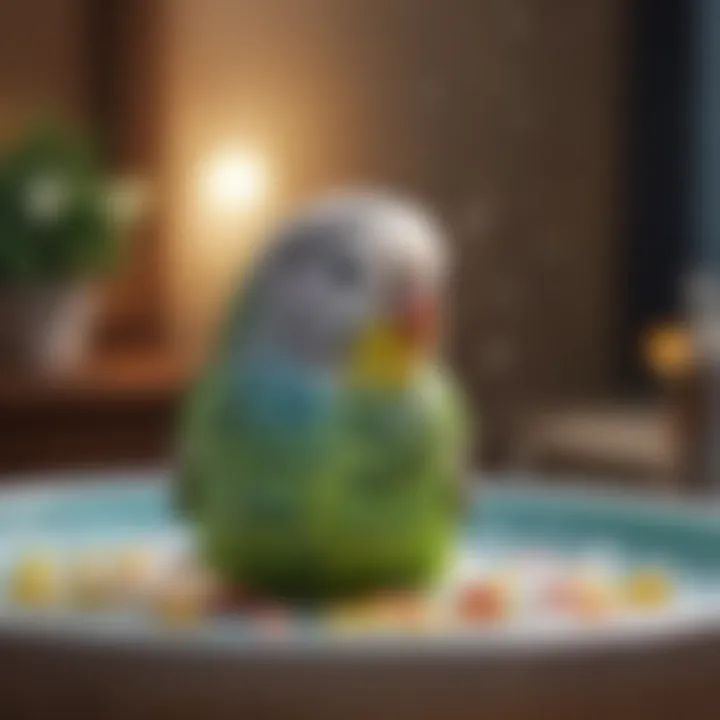
Intro
Bird baths are essential for the care and well-being of budgies. Understanding how to incorporate them into your pet bird's routine enhances their hygiene, physical health, and mental state. Budgies, like many birds, require regular bathing to maintain clean feathers and prevent stress or behavioral issues. This provides a vital opportunity for interaction and enrichment.
In this guide, we will explore the various aspects of bird baths, from types and frequency to proper introduction techniques for unfamiliar budgies. This information is crafted for those aspiring to become knowledgeable avian custodians or seasoned bird owners looking to refresh their understanding. Good bath practices result in happier, healthier budgies.
Care Tips
Daily Care Routines
Establishing a daily care routine is fundamental for the overall welfare of your budgie. It is crucial to provide consistent access to clean water, fresh food, and a stimulating environment. Budgies thrive on routine. Designating a specific time for bathing helps them recognize this activity as a part of their daily life.
Cage Setup and Maintenance
The cage needs to be spacious and well-organized for optimal comfort. Ensure a safe and accessible area for bathing that is away from drafts and is versatile to accommodate different bathing styles, such as bowls or spray mists. Ensure periodic modifications are made to the setup for varying seasonal demands, especially in areas like temperature control.
Hygiene and Cleaning Practices
Maintaining hygiene is crucial not only for the health of your budgie but also for the environment within the cage. Bird baths should be cleaned daily to prevent the buildup of harmful bacteria. Use plain water or a gentle avian-safe cleaner without harsh chemicals. Regular cleaning periods demonstrate your commitment to your budgie’s well-being.
Seasonal Care Adjustments
Seasonal changes can affect bathing habits for budgies. In summer months, many birds may enjoy more frequent baths, while colder weather could necessitate fewer baths or the use of heated water. Monitor your budgie’s comfort level and adapt accordingly to help them feel secure in their care routine.
Behavioral Insights
Understanding Bird Body Language
Observing a budgie’s body language is essential to understand its mood and needs. Look for signs like puffing feathers, gentle wing flapping, and chirping. Each action speaks volumes about their current state, including their willingness to explore new routines like bathing.
Common Behavioral Issues and Solutions
Bathing-related difficulties may stem from fear or unfamiliarity with the process. Offering gradual introduction through gentle spraying or placing shallow water and allowing the budgie to investigate is helpful. Each bird will have a unique comfort threshold.
Positive Reinforcement Techniques
Employing positive reinforcement creates a safer space for budgies to explore new routines. Rewarding them with praise or safe treats during and after bath time encourages them. This builds their confidence, thereby reducing potential negative behaviors.
Social Interaction Needs
Budgies are highly social creatures. They benefit from the companionship of their human caregivers or their kind. Incorporating bath time into shared activities enhances their emotional well-being. Observing their responses each time fosters a better human-budgie bond.
Nutrition Guides
Essential Diet Components
A balanced diet is crucial for a budgie's vitality. Incorporating seeds, pellets, and an assortment of vegetables ensures nutritional adequacy in their daily intake. Feeding them healthy treats occasionally makes the experience enjoyable.
Safe and Toxic Foods
Understanding what foods are safe is imperative. Avoid feeding them chocolate, avocado, or rhubarb as these can be harmful. Always refer to reliable sources or guidelines while choosing food options for your budgie.
Supplements and Treats
Supplements can aid in providing your budgie with the necessary vitamins and minerals not available in their regular diet. Treats like cuttlebone or mineral blocks are encouraged, as they support beak health.
Feeding Strategies for Different Species
Different budgie species might have variable needs. Conduct research to understand the specific dietary requirements for your budgie species. What works for one may not yield the same results in another.
Wellness and Health
Routine Health Checkups
Routine checkups with an avian vet ensure early detection of health issues. Following standard schedules for health assessments is important in prolonging your budgie’s lifespan.
Identifying Symptoms of Illness
Birds can exhibit odd behaviors when unwell. Identify indicators like lethargy, lack of interest in food, or changes in droppings. Each can be initial signs of potential health challenges.
Preventative Care and Vaccinations
Keeping your budgie up-to-date with vaccinations and preventative care helps protect them from common avian diseases. Discuss with your avian veterinarian to set up a comprehensive preventative health program for your bird.
Mental and Emotional Well-being
Wellness extends beyond physical health. Engaging flying, foraging, and social encounters are essential for your budgie’s emotional health. Creating a space where these activities are encouraged can make a significant difference.
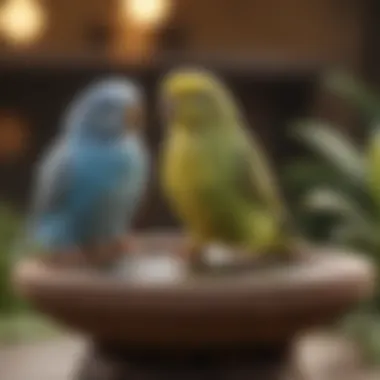
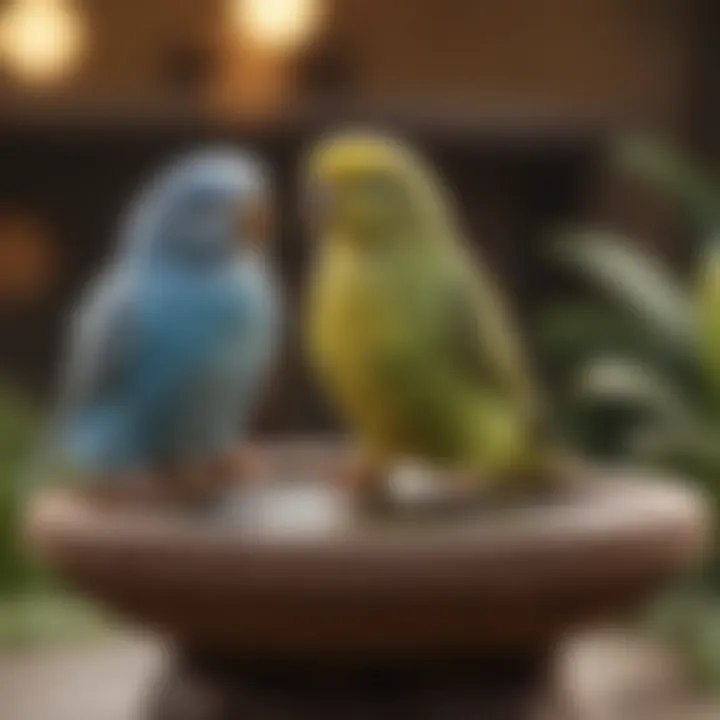
Enriching Activities
Toys and Playtime Ideas
Provide a stimulating environment with toys of different textures and types. Toys made of natural materials are particularly beneficial as they engage the bird while fulfilling their need to chew.
Training and Tricks
A fun way to interact with your budgie is through training for simple tricks. Start with effortless commands and reward successfully completed tasks with special treats, helping to foster a sense of accomplishment.
Outdoor Activities and Interaction
Allowing your budgie outdoor time enhances their environment. Train them for safe outdoor experiences, where they can enjoy fresh air under supervision. Matching this with bath time can create appealing atmospheres.
DIY Projects for Mental Stimulation
Do-it-yourself projects can keep your bird engaged. Creating homemade toys or interactive play structures provides an entertaining avenue to stimulate. This creativity enriches both your and your budgie's experience.
Understanding the integral relationship between your budgie's bathing habits and their overall health creates a healthier experience for both you and your feathered friend.
Intro to Budgie Bird Baths
Bird baths are essential elements of proper budgie care. They serve several essential functions that neo and seasoned budgie owners must understand. This introduction provides clarity about the various reasons budgies benefit from regular bathing, which is crucial for their health and safety.
The Role of Bathing in Budgie Care
Bathing has a significant role in a budgie's daily routine. Whether they are in the wild or domesticated, these birds instinctively require access to water for bathing. It helps them in various ways:
- Hygiene: Regular bathing helps budgies maintain feather quality. Clean feathers provide insulation and enable the birds to regulate body temperature, which is crucial for overall health.
- Physical Health: Bathing contributes to a budgie’s health by removing dirt, excess oils, and debris that accumulate on feathers. Damp feathers lead to high moisture levels, which are essential for alllow portraits that aid in proper flight.
- Cooling Mechanism: Budgies, like many birds, use bathing to help control body temperature, especially during warm weather.
Moreover, bathing provides a stimulating activity. It allows these curious creatures to engage with their environment in a natural way, helping to prevent boredom associated with captivity, producing happier and healthier birds.
Evolution of Bird Bathing Practices
Historically, and long before domestication occurred, birds practiced bathing. Initially, early birdwatchers noted that wild budgies would seek out fresh sources of water, from shallow puddles to lakes. Additionally, other birds also shared life-giving water sources, pioneering unique bathing styles. These behaviors gradually inspired the development of a wide range of bathing methods and contraptions designed specifically for avian companions.
Evolution illustrates our evolving comprehendion of birds’ needs. Bathing systems today are designed with enhanced functionality, hygiene qualities, and are thoughtfully crafted to support budgie behaviors while prioritizing their welfare.
Benefits of Bathing for Budgies
Bathing serves several crucial functions in the lives of budgies. As natural avians, these birds have evolved in environments where water sources are accessible. Consequently, within captivity, it's necessary to mimic these conditions to promote their welfare. The act of bathing not only contributes to their physical health but also influences their behavioral patterns. Understanding the various benefits of providing a proper bathing experience for budgies can equip pet owners with the knowledge required for better practice.
Physical Health Advantages
Physical well-being in budgies is significantly enhanced through regular bathing. One pivotal advantage is feather maintenance. Clean feathers are vital, as they ensure proper insulation and waterproofing. Budgies constantly preen their feathers, and bathing is part of this routine. Regular baths help remove dirt, allergens, and excessive oils that can accumulate over time.
Another health benefit relates to skin condition. Just like humans, budgies can retire into skin conditions if proper hygiene is neglected. A well-hydrated bird is less likely to face issues like flaky, itchy, or dry skin. Notably, water can bring relief to a budgie’s skin from irritations often caused by the environment.
In essence, maintaining good health through bathing reduces the likelihood of diseases caused by poor hygiene. Some pet owners notice reduced instances of feather plucking or bacterial infections after establishing a bathing routine for their birds. Here are more advantages:
- Encourages blood circulation through movement in water.
- Reduces the chance of parasite infestations.
- Can alleviate signs of stress and discomfort.
Behavioral Insights
The behavioral traits of budgies are deeply intertwined with their psychological well-being. Bathing offers an understanding of their tenacity and needs. When provided with access to a bath, it can trigger natural instincts, providing insights into their behavior. Experimenting with bathing frequency and type can yield specific insights into each budgie’s preference. For instance, some budgies display immediate enthusiasm, while others may require more time to adapt.
Additionally, bathing is often a bonding activity and a way for budgies to establish their territory. Birds tend to assess each other’s bathing behavior, establishing social bonds in both solitary and collaborative environments.
Dirty feathers often prompt calls for communal grooming among flock members, allowing for greater interaction and a safer space.
In summary, the benefits of bathing are multifaceted, influencing both health and social structure. Bathing acts as an important part of a budgie's life, nurturing their physical stance and social behavior.
Regular bathing not only maintains physical health but is essential for emotional well-being in both captive and wild budgies.
Types of Bird Baths
The type of bird bath selected plays a crucial role in the overall bathing experience for your budgie. Different styles offer distinct benefits and drawbacks. Understanding these options can help avian enthusiasts make informed decisions on what suits their situation best.
Freestanding Bird Baths
Freestanding bird baths are standalone structures, typically placed on the ground or lawn. Their design often appeals to bird owners looking for flexibility in placement. These baths are usually deep enough to accommodate various bird sizes, providing quite an appealing space for your budgie to engage in an enjoyable splash routine.
Benefits of Freestanding Baths:
- Portable and easy to move as per seasonal changes.
- Often feature larger water basins, promoting better cleaning and social interactions among birds.
However, it is important to consider that freestanding baths require more frequent maintenance, as they can attract other neighborhood birds or insects.
Mounted Bird Baths
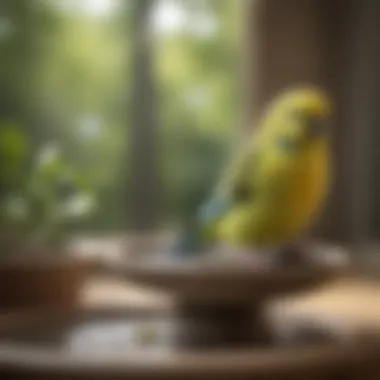
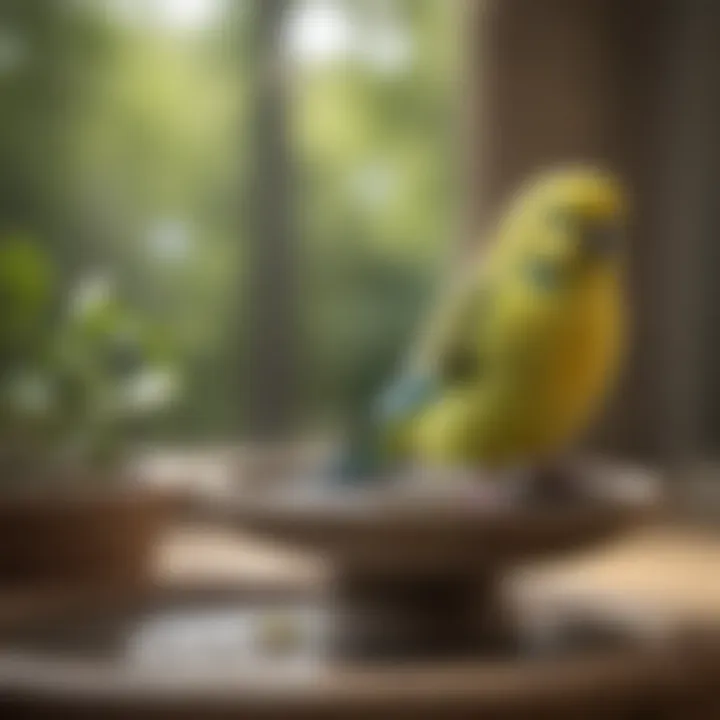
Mounted baths are attached directly to a surface, such as a wall or a deck railing. This design offers unique advantages for users in need of saving space or who aim to provide a safe and controlled bathing environment for their budgies. By elevating the bath, you can minimize exposure to dirt and contribute to cleaner water.
Advantages of Mounted Baths:
- Space-efficient, suitable for smaller living environments.
- Holds a compact design, which reduces the risk of contamination from ground interactions.
One drawback is the potential risk if the budgie does not find comfort in being high off the ground. Monitoring your pet's behavior near these baths is essential.
DIY Bird Bath Options
For creative and resourceful bird enthusiasts, building a DIY bird bath can be a meaningful project. DIY options range from simple containers placed in the garden to elaborate setups using materials found at home. This allows owners to customize size, shape, and location based on their requirements.
Things to Consider When Making a DIY Bath:
- Use bird-safe materials, ensuring there are no harmful coatings or substances.
- Consider the depth and width to guarantee ease of use for your budgie.
"A well-designed bath can promote health and happiness in your budgie, enriching their lives fundamentally."
With these correlations and options presented, knowing how to choose the right type of bird bath aligns closely with offering an optimal environment for trusty companions. Selecting beneficial setups helps communicate to your budgie that self-care is valued and appreciated.
Choosing the Right Bath for Your Budgie
Selecting the appropriate bird bath is essential for promoting the health and well-being of your budgie. The right bath can help ensure proper hygiene, provide an enjoyable experience, and complement your budgie's living environment. Careful consideration of multiple factors ensures that the bathing experience meets the natural instincts of your pet budgie.
Size and Accessibility
When choosing a bird bath, size is a primary concern. It is vital to select one that fits well within the space allotted for your cage or designated bird area. Budgies are small birds but they require enough space to move about freely when cleaning themselves. A larger bath can provide a more accommodating and comfortable experience. However, the bath should not be too large, where it may overwhelm the bird or be hard for your budgie to access.
Additionally, accessibility plays a critical role. Placement should be at a height where your budgie can easily enter and exit without difficulty. Some owners find success with shallow dishes that can be placed directly on the cage floor while others prefer wall-mounted options. Each budgie is distinct and preferences may vary from bird to bird.
Material Considerations
Choosing the right material for a bird bath is equally important. Non-porous materials such as glass and stainless steel are recommended since they do not retain bacteria and are easier to clean. Some birdbaths are made from plastic, but it is essential to choose high-quality, bird-safe plastics to avoid leaching chemicals into the water.
Ceramic baths might seem aesthetically pleasing but they can become heavy and difficult to handle. Make sure any material used is sturdy and can withstand the activity and movement your budgie creates during bathing.
Location and Placement
The location of the bird bath directly affects how comfortable your budgie feels while bathing. It is advisable to place the bath in a secure, familiar area of the cage. Rapid changes in location may disturb your bird. Furthermore, avoiding overly bright direct sunlight is wise, as it can lead to stress and discomfort. A dimmer or partially shaded spot can help create a relaxing bathing environment.
Moreover, consider safety from other pets if you have more animals in your home. The location should minimize stress for the budgie by providing an option away from strays: dogs or cats. Providing a private and secure location can enhance the bathing experience.
Remember, the ideal bath not only improves hygiene but also contributes to your budgie's happiness and overall health.
In summary, selecting the right bath for your budgie involves careful consideration of size, accessibility, materials, and location. These factors work together to create a positive experience. This attention to detail demonstrates the commitment of care that your bird deserves.
Frequency of Bathing
Bathing is not just a hygiene routine for budgies; it is a vital part of their overall well-being. Determining how frequently to offer a bath is crucial for their health. Bathing helps budgies maintain their feather quality, keeps their skin moisturized, and can even have benefits for their mental state. Let's delve into two important aspects: understanding budgie behavior and the environmental factors that impact bathing frequency.
Understanding Budgie Behavior
Budgies are naturally inclined to bathe, as they are used to having access to water in their natural habitat. Typically, a budgie will showcase signs that indicate their desire to bathe. Puffed-up feathers, splashing in their water bowl, or even vocalizations may suggest they are in need of a bath. Watch for these signals closely; understanding your budgie's behavior helps you decide on the right timeframes for bathing.
Key behavior cues to observe include:
- Increased vocal activity
- “Dancing” in water, flapping their wings
- Frequent preening, showing eagerness to fluff up
Bathing preferences will vary from one budgie to another. Some may prefer a daily bath while others tolerate only periodic bathing. Knowing your budgie is key to maintaining a healthy routine and adjusting frequency according to their comfort level and needs.
Environmental Factors
Numerous environmental elements can influence how often you should provide a bath for your budgie. Factors like indoor humidity, temperature, and even the feather condition of your bird play a role. In dryer climates, a budgie may need more opportunities to bath in order to keep feathers and skin healthy. Alternatively, if your space has higher humidity, you might consider reducing bathing frequency, monitoring for any signs of excess moisture on their feathers.
Consider these environmental aspects:
- Temperature: Budgies in warmer environments often enjoy more frequent baths.
- Humidity Level: Dry air may require more baths for skin health.
- Feather Condition: Birds in molt need more frequent access to bathtubs.
Ultimately, finding a balance based on both individual behavior and environmental conditions can help ensure that budgies maintain optimal health. Adjusting the bathing frequency accordingly fosters happier birds and healthier habitats.
Finding the right balance between your budgie's needs and environmental conditions can make a difference in their happiness and well-being.
End this process by routinely observing your budgie to adjust the bathing frequency based on active behaviors and these environmental referrals. Regular engagement will help you form a better understanding and create a suitable bathing routine for your feathered companion.
Introducing Bathing to Your Budgie
Introducing bathing to your budgie is a crucial part of their overall care and hygiene. Many budgies are instinctively attracted to water and find it essential for keeping their feathers clean. Providing them with an appropriate bath can lead to happier, healthier pets. Underestimating the role of water in a budgie's life hampers their physical well-being and could impact their behavior. In this section, we will explore the natural reactions of budgies to water and how to properly acclimatize them to bathing.
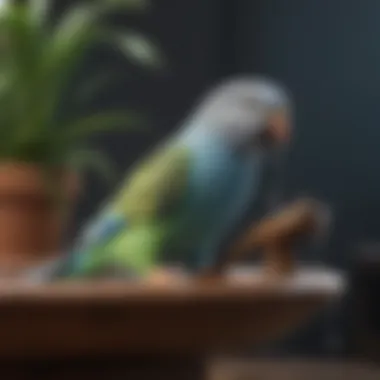
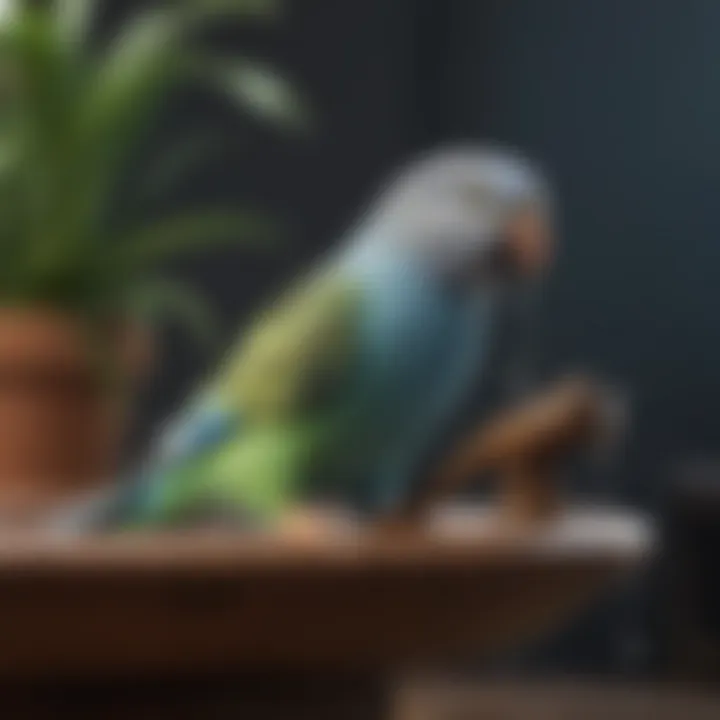
Understanding Budgie Reactions
Budgies, like all birds, have unique responses to water. Some may immediately display excitement and enjoy splashing around. Others may exhibit caution due to unfamiliarity. Observing taking a scalelike approach of assessing their reaction can help you understand their comfort level with t heater environment. They might first dip a toe in water, slowly gaining confidence before fully engaging. Some common reactions include:
- Curiosity: Budgies are naturally curious creatures. When greeted with a new environment that includes water, they may peer at it and investigate.
- Hesitation: A budgie may step back initially if they have negative past experiences. This reaction is typically due to a lack of familiarity, not a dislike of water.
- Playfulness: If comfortable, they will sometimes play in the water, flapping their wings or even enjoying a little splash. This is a sign that they have adjusted well to the bathing experience.
It is vital to carefully monitor their behavior during this introduction phase to ensure that they remain safe and happy. If there are signs of stress or discomfort, it could be necessary to reevaluate the bathing approach.
Gradual Acclimatization Techniques
Acclimatizing your budgie to bathing requires patience and tact. Progressive steps can be taken to cultivate a positive relationship between your bird and their bath ~ the less abrupt the introduction, the better response you often get.
Simple techniques include:
- Observe First: Let your budgie watch you while you fill the bath. It may encourage their curiosity naturally.
- Use Shallow Water: Start with minimal water in the bath. Budgies often prefer to feel in control of their paddling. Too much water can be daunting for those unfamiliar.
- Tentative Exploration: Allow them to approach the bath with their essential movements – allow them to hop close and back away repeatedly.
- Emotional Halo: Offer a treats or favorite snacks nearby to foster positive feelings associated with the water experience. Eventually, when they tire of watching, they will want to enter in search for reward.
- Daily Routine: Regular exposure day after day should help your budgie view bathing as another normal aspect of their life. Keeping a set routine on specific days will draw them in more.
Cultivating comfort with water leads to confidence, which translates to enhanced overall hygiene for your beloved pet. As a result, both the perceptiveness to groom their feathers and preferences become noticeably evident.
Remember, not every budgie will express interest in bathing at first. Every bird has an individual personality, and the goal is to make this experience as enjoyable as possible.
Taking time for gradual acclimatization will pay off, and allow budgies in good comfort, leading conducive behaviors and hopefully enthusiastic splashes in their next bather venture.
Maintenance of Bird Baths
Maintaining a clean and safe bird bath is a crucial aspect of budgie care. A well-maintained bath ensures that your feathered friend can bathe comfortably, promoting hygiene and overall health. Improperly maintained baths can lead to various issues, including water contamination and health risks for the budgie. By understanding the best practices for maintenance, bird owners can provide an optimal bathing environment that fosters well-being.
Cleaning Practices
Regular cleaning is essential to keep the bird bath free from dirt, debris, and bacteria. Here are some recommended practices:
- Frequency of Cleaning: Clean the bird bath at least once a week, or more often if you notice any buildup of dirt or algae.
- Cleaning Solutions: Use mild soap or vinegar to clean the bath. Avoid harsh chemicals that may harm the birds.
- Scrubbing: Use a sponge or cloth to scrub the interior surfaces gently. Pay special attention to corners where grime may accumulate.
- Rinsing: Thoroughly rinse the bath with clean water after scrubbing to remove all cleaning agents. Residue from cleaning chemicals can be harmful to birds.
By following these cleaning practices, you can ensure that the water remains clean, safe, and refreshing for your budgie.
Water Quality Management
Water quality is critical in preventing health issues for budgies. The quality of water in the bird bath can directly affect the bird's health and enjoyment.
- Fresh Water: Always provide fresh water for bathing. Contaminated water can lead to sickness or infections.
- Checking for Contaminants: Regularly inspect the water for any floating debris, dead insects, or residue from cleaning products.
- Temperature: Ensure the water is at a suitable temperature. Budgies often prefer room temperature water, so be mindful when adding it to the bath.
- Changing Water: Replace the water daily, especially during warmer months; this helps prevent stagnation and keeps bacteria at bay.
Maintaining high water quality not only helps your budgie stay healthy but also encourages regular bathing habits. The more inviting the bath, the more your budgie will enjoy it.
By implementing effective water quality management, you create a safe bathing environment. It enhances hygiene and keeps your budgie healthy and happy.
Common Issues with Bird Baths
When discussing bird baths for budgies, it is essential to recognize potential problems that may arise. These issues not only affect the cleanliness and effectiveness of the baths but also can significantly impact the well-being of the birds. Understanding these challenges is crucial for bird owners aiming to ensure a safe and healthy environment for their budgies.
Water Contamination
Water quality is a prevalent concern when it comes to pet bird baths. Contaminated water can lead to diseases, skin problems, and other health challenges in budgies. Several factors contribute to this issue:
- Organic Debris: Droppings or uneaten food can decay in the bath, affecting the water quality.
- Bacterial Growth: Harmful bacteria can flourish in stagnant water, creating a breeding ground for infections.
- Chemical Contaminants: Products used nearby, such as pesticides or cleaning agents, can inadvertently get into the bird bath.
To mitigate these risks, owners should implement regular cleaning routines. It's advisable to:
- Change the water at least once daily.
- Scrub the bath with bird-safe cleaners periodically.
- Ensure that the bathing area is kept free from food or droppings.
Regular maintenance can significantly reduce water contamination levels, leading to a healthier bathing experience for your budgie.
Budgie Safety Concerns
Safety is paramount when introducing or maintaining bird baths. There are aspects to consider that may pose risks to your budgie's well-being:
- Slip Hazards: Wet surfaces can become slippery. It's vital to select baths with textured bases to help prevent falls.
- Depth Considerations: A bath too deep may panic a budgie. Shallow designs are recommended to allow the birds to bask comfortably without feeling overwhelmed.
- Exposure to Elements: Placing baths outdoors exposes budgies to predators, which can be a significant threat. A sheltered location is preferable, ensuring a covered and secure bathing spot.
As a best practice, owners should constantly supervise their birds during bathing time, especially outside. Maintaining safety not only contributes to their confidence but to their overall enjoyment as well.
End
As we summarize the significance of budgie bird baths, it becomes clear that they are more than mere accessories for these vibrant companions. The regular use of baths plays a critical role in maintaining the hygiene and vitality of budgies. Not only do baths help budgies maintain a clean feather coat, which is essential for their thermoregulation, but they also promote grooming behaviors that are vital for their mental well-being.
Recap of Key Points
- Promoting Hygiene: Baths effectively remove dirt and debris from their plumage.
- Health Benefits: Consistent bathing habits can contribute to healthier skin and reduce issues like feather plucking.
- Variety of Bath Types: Many options exist for bird baths, from mounted styles to charming DIY projects.
- Location and Accessibility: Ensuring your budgie can access their bath with ease enhances bath usage.
- Monitoring Water Quality: Clean water is paramount to preventing contamination that can harm your bird's health.
Overall, providing a suitable bathing arrangement is crucial for ensuring the longevity and happiness of your budgie.
Encouragement for Responsible Bird Care
As responsible caregivers, it is our duty to remain informed and attentive to our budgies' needs. Integrating baths into their routine is just one piece of the puzzle. Each decision should reflect a commitment to their well-being.
Responsible bird care entails observing your budgie's behavior when introducing bathing practices. Adapt and modify based on their reactions. Remember that keeping their bath place clean and free from harmful elements confirms your dedication to your pet's health.
Embrace the joy of sharing your life with these bright creatures, and always consider their comfort and safety as a priority. Research, ask questions, and engage with communities, such as reddit.com and facebook.com, to broaden your knowledge. Your budgie is more than a pet; they are part of your family. Their health is a reflection of your commitment to reliable care.















